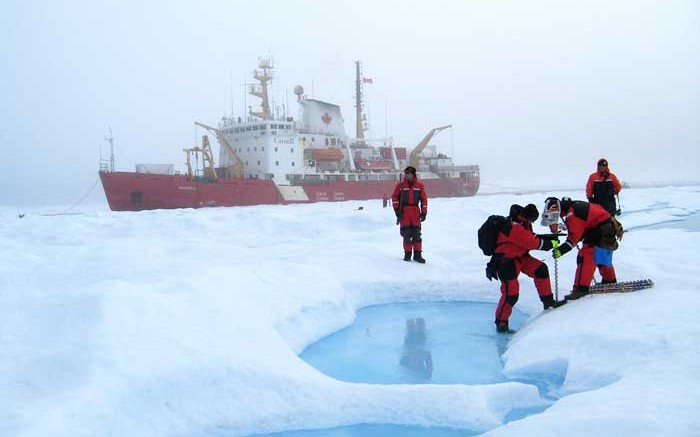VANCOUVER — Natural resource development in Canada can come with unique challenges owing to isolated locales and frigid weather. But the federal government is hoping it can make life a bit easier for miners and other parties involved in northern economic development with an Arctic program launched through the National Research Council (NRC).
Prime Minister Stephen Harper launched the initiative during his ninth annual “northern tour” at an address in late August at the Yukon Research Centre at Yukon College.
The “NRC Arctic” program supports research in resource development, northern transportation and shipping, marine safety technologies and community infrastructure. Research will develop and commercialize cold-climate technology, with the program costing $17 million over eight years. The government will seek another $65 million in co-investments from industry partners.
“Our government recognizes the full potential of the North,” Harper said in a prepared statement. “We will continue to support northern development by ensuring sustainable, low-impact, responsible resource development in the Arctic, while creating jobs and improving the quality of life for residents of Northern communities … [we are] committed to harnessing science, technology and research to further develop Canada’s North.”
The NRC is seeking partners across the mining, transportation and energy sectors. Collaborators would access unique expertise, competitive rates, and customized service options that would ensure data integrity and confidentiality.
The NRC offers “state-of-the-art” modelling and testing facilities that support activities in various sectors, including: marine and ice technology services, performance, evaluation and optimization services, and northern construction.
Research will focus on the safety of resource development in ice-covered waters; increasing the number of days of operational use of ice roads; the performance of immersion suits in a cold and harsh ocean environment; and increasing energy efficiency and durability of northern housing, thereby decreasing the cost of maintenance and repairs.
A few major Canadian producers are operating large-scale mines in Arctic regions. Teck Resources (TSX: TCK.B; NYSE: TCK) has long-standing experience at its Red Dog zinc mine and Kinross Gold (TSX: K; NYSE: KGC) operates the Fort Knox gold mine, which are both located in Alaska.
Meanwhile, the Northwest Territories has become a global diamond-mining centre due to the Ekati and Diavik discoveries in the 1990s, with Ekati now operated by Dominion Diamond (TSX: DDC; NYSE: DDC) and Diavik operated by Rio Tinto (NYSE: RIO; LSE: RIO).
Other major outfits include Glencore (LSE: GLEN) at its Raglan nickel operation in northernmost Quebec, and Brazil’s Vale (NYSE: VALE) at the prolific Voisey’s Bay nickel mine in Labrador’s east coast.
The newest major mine development in the Canadian Arctic is Agnico Eagle Mines’ (TSX: AEM; NYSE: AEM) at its Meadowbank gold mine, 300 km west of Hudson Bay. The operation became Agnico’s largest gold producer in 2013, but that success came at a steep price due to its isolated location. The company ended up investing US$2 billion to get Meadowbank into production. The mine cranked out 118,161 oz. gold during the second quarter at total cash costs of US$577 per oz.
“We are working with partners to develop a comprehensive system to provide detailed information about year-round environmental conditions throughout the Canadian Arctic. This will enable mariners to more accurately assess risks for shipping, especially when they are considering operating vessels to a new market, such as a new mining project,” NRC general manager Terry Lindstrom noted in an email to The Northern Miner.
“We’re also investigating methods for extending the longevity of seasonal ice roads. Several mining companies use winter ice roads, as they are well away from any permanent infrastructure system. The program work in this area will study the existing ice road creation techniques, operating windows, spatial range of use and usage rates across the Arctic, bearing capacity guidelines on ice, and developing technologies to naturally reinforce ice sheets,” he added.
The Canadian government’s efforts come at a time of socio-political tension over natural resource rights in the Arctic. Technically, no country owns the geographic North Pole and the surrounding region of the Arctic Ocean.
According to the United Nations’ Convention on the Law of the Sea, the five countries that hold territory within the Arctic Circle — Canada, the U.S., Norway, Russia and Denmark/Greenland — have economic rights over 300 km wide “economic zones” hugging their northern coastlines.
On Oct. 29 Russia’s Minister of Natural Resources Sergei Donskoi revealed that Russia’s research indicates it should gain another 740,000 sq. km in the Arctic, which it believes could host “at least” 4.5 billion tonnes of unexploited oil and gas reserves.
“Obtaining the approval of the UN Commission on Russia’s bid will not only expand [our] borders, but give a glimpse into the future in terms of Arctic development strategy for the country, as we expect in this area quite significant hydrocarbon reserves,” Donskoy stated.


Hello,
The announcement was made at the Yukon Research Centre at Yukon College, NOT the Yukon Innovation Centre as mentioned in the first paragraph. Thank you.